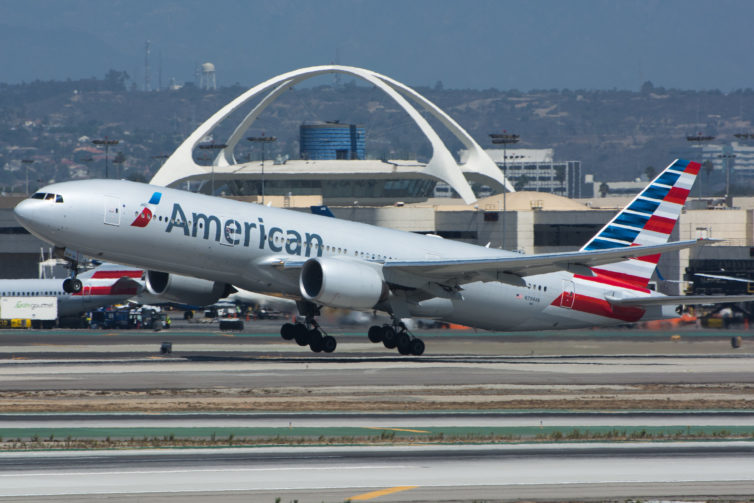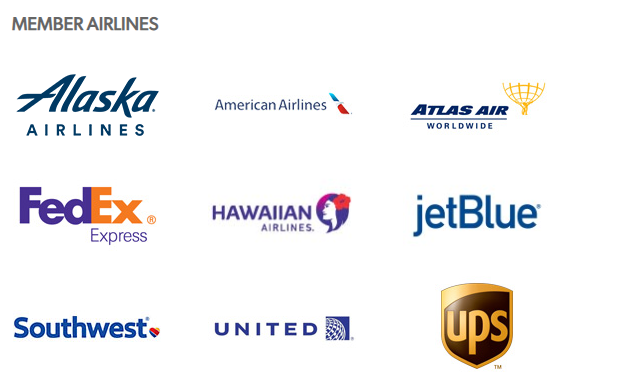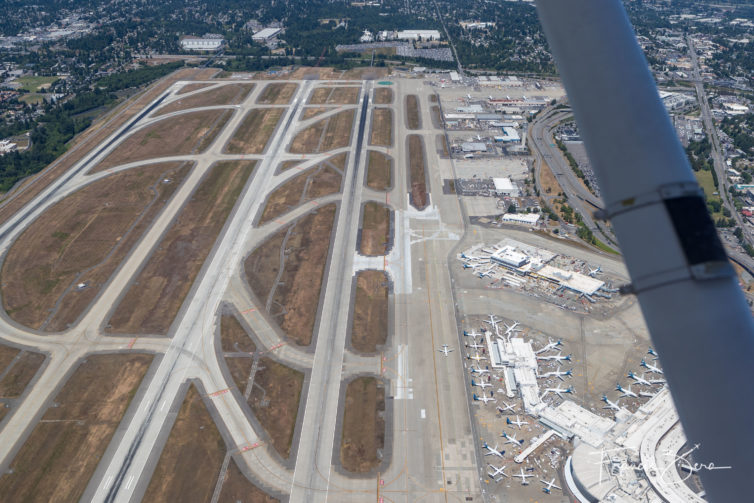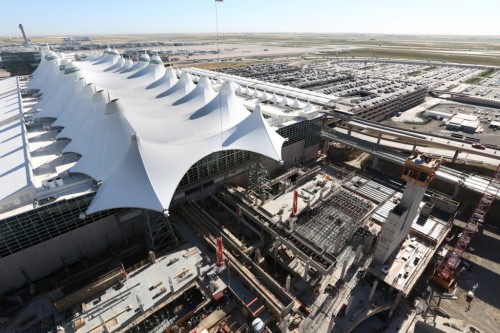
American 777-200ER departing from LAX with the iconic Theme Building and control tower, as seen from the Imperial Hill viewpoint – Photo: Jason Rabinowitz
Airlines are AWESOME! They enable travel at a rate faster and cheaper than at any point in human history, and at an uncompromising level of safety. They enable business and connect us with the world in ways which, just a few generations ago, would have been considered impossible. For some of us, airlines sustain our relationships. AirlineReporter exists because of our collective passion for airlines, travel, and aviation. But being a fan of any particular industry comes with some risk.
Sometimes good companies and organizations do bad things. And when that occurs, it’s important to first understand what’s happened, and then take action. In a civilized society, we do our best to look past minor disagreements and remain focused on the big picture. But what about egregiously misleading marketing? How does someone who loves the airline industry declare mutiny on one of their trade groups? For months we’ve pondered this question and have struggled in an identity crisis as a result. So we will do what we do best… we’ll cover this conundrum from a unique perspective.
 #StopAirTaxNow! Have you seen these ads around social media? In today’s crazy political environment, it’s just another call-to-action marketing campaign. You know the routine: Trigger folks at the mention of taxes, urge them to phone their elected officials, pick up their pitchforks, and maybe start a revolution. Overreaction? Possibly. But these things are a slippery slope. What sets this campaign apart is that it is funded by airlines we all know and rely on (and sometimes love).
#StopAirTaxNow! Have you seen these ads around social media? In today’s crazy political environment, it’s just another call-to-action marketing campaign. You know the routine: Trigger folks at the mention of taxes, urge them to phone their elected officials, pick up their pitchforks, and maybe start a revolution. Overreaction? Possibly. But these things are a slippery slope. What sets this campaign apart is that it is funded by airlines we all know and rely on (and sometimes love).
Let’s dig in…
What is Airlines for America?
Airlines for America (A4A) is an industry trade group which represents most of the major U.S. airlines. A4A influences “on behalf of its members to shape crucial policies and measures…” A4A is to airlines what the Tobacco Institute was for “big tobacco,” what the American Medical Association is for doctors, and the Chamber of Commerce is to business. Thinking broadly, these groups are a way for constituents to pool money, share ideas, and ultimately, collectively influence opinion.
Whose opinion are we influencing? Consumers, for sure, but the big money is influencing those in a position to regulate. These consumer-facing calls to action, in fact, urge customers to show their support in a public way which influences elected officials. It turns out the opinion influencing business is a great one to be in. In 2012, NPR’s Planet Money team reported on a study which showed a substantial return on investment for every dollar invested in lobbying. According to the piece: that means for every dollar spent on lobbying, the companies got $220 in [benefits.]
There’s a hidden tax on your airline ticket, and now some in Congress want to raise it even higher. Follow us to tell Congress that tax hikes won’t fly with you.
— StopAirTaxNow (@StopAirTaxNow) August 12, 2019
What’s a PFC?
A PFC, or Passenger Facility Charge, is what A4A is incorrectly referring to as their so-called “air tax.” In fact, PFCs are usage fees in that those who use airports pay for them. If you don’t fly, you don’t pay. Taxes, on the other hand, are less surgical. My guess is that by intentionally mislabeling this usage fee as a tax, A4A is hoping to successfully kindle the same outrage as when estate taxes were branded by those opposing them as “death taxes.” This logic is fundamentally flawed, intentionally deceptive, and throws back to sensationalism in the hopes of reaction.
We have a great primer on what PFCs are and how they help airports operate. Here’s an excerpt from that piece: The PFC is a fee that is automatically applied to the purchase of airfare that airlines collect on behalf of the [airports.] The airlines, in turn, transfer this money over to the airport, minus a small collection fee. [it is variable from airport to airport, but is currently capped at] $4.50 per flight segment, not to exceed $9 for a one-way trip or $18 for round-trip travel. These limits were last adjusted in the year 2000. In the past 19 years, thanks to inflation, the purchasing power of the $4.50 PFC has dropped by at least a third or more by some calculations.
Why should I care?
First, we need to address the bad behavior of A4A intentionally misleading consumers. A4A is funded by airlines which in recent years have performed quite well, making record profits. There is no room in public discourse for lobbying firms funded by for-profit entities to attack well-meaning non-profit airports with blatantly misleading marketing. Without airports, we have no airlines. A4A and its constituent airlines need to be good partners and present the facts as they are, without embellishment. As my high school debate coach used to preach, “If your position is strong, there’s no need to mislead.”
I’ve mentioned a few times that PFCs are just one way airports are funded. Another is through Grants-in-Aid for Airports via the Airports and Airways Trust Fund (AATF). Money in this fund comes from a 7.5% sales tax on airline tickets, as well as taxes on fuel and other aviation-related goods and services. As noted by our friend Tom Rainey on NYCaviation, the 7.5% tax on tickets does not apply to airline fees. Airline fees are those so-called “optional” add-ons such as checking a bag, changing a flight, or even selecting a seat. I find it curious that an industry which has taken such a liking to fees to suddenly lash out at airports for wanting the option to make modest increases to their own. The hypocritical nature of airlines collecting less in taxes due to unbundling, while profiting from their own fees and attempting to deny airports funding is really quite incredible.
This hypocrisy is obvious. So much in fact that Airlines for America’s marketing program on Twitter prompted a severe backlash from the general public. Chipping in a few bucks to airports, it seems, isn’t the polarizing issue A4A had hoped it would be. A4A seems to have learned their lesson, and on June 6 pivoted their disinformation campaign away from @AirlinesDotOrg to their less obvious @StopAirTaxNow account. From my perspective, hiding behind a less obvious account only proves the point that this isn’t a winning issue in the public eye.
What do the airports have to say?
It turns out that the airports have their own lobbying group, called the Airports Council International, (ACI). I reached out to Scott Elmore, VP of marketing and communications for the North American region, to get their take on A4A’s arguments.
“The same airlines that have no issue charging fees for checked bags, seat assignments, and reservation changes are trying to block airports from making much-needed infrastructure upgrades. Despite what airlines say, America’s airports face $128 billion in infrastructure upgrades over the next few years. Anyone who has been in an airport recently can attest to that.”
While chatting with Scott and his PR representatives I presented the claims that A4A makes on their StopAirTaxNow site. Below are the A4A claims with the ACI-NA comment presented as they are. You be the judge– Is it too much to ask that airports be allowed the option to make modest increases to the PFC to help fund infrastructure? Or are the airlines right? Let us know what you think in the comments below.
Airlines: Customers are already paying $6.9 billion per year in airport taxes, helping airport revenues to soar to a record of nearly $30 billion.
Airports: The cost of operating an airport is high. After airports cover their daily operating expenses there is little left for capital intensive infrastructure projects. In addition, airports are required to hold large cash reserves when they utilize the bond market to finance projects. Airports face almost $92 billion in debt right now to pay off past projects, and the borrowing costs are excessive thanks to a restricted PFC.
Airlines: There is also almost $7 billion sitting in the aviation trust fundthat’s billions of dollars that can be spent on infrastructure instead of charging passengers more.
Airports: The big airlines fall short of actually saying the unobligated balance in the Airport and Airway Trust Fund should go to airports. The trust fund ’“ which is used to fund AIP grants, FAA facilities and equipment, and the air traffic control system ’“ may enjoy a healthy balance today, but that has not always been the case. It would be irresponsible to bankrupt a trust fund that is so important to all of FAA’s activities.
Airlines: Airport revenues are diverted off-airport every year ’“ almost $5.4 billion in the past 10 years ’“ money that could have been used for airport infrastructure.
Airports: This is missing a lot of context. Congress has exempted 12 ’œport authorities’ from the FAA’s revenue diversion rule because of the complexity of bond issuances for the handful of affected airports. In the case of these airports, it is the authority, state, or city that actually issues the bond, rather than the airport itself. Changing this standard ’“ even for this small group of impacted airports ’“ would have significant negative implications on the authorities as bondholders, could jeopardize billions of dollars of construction projects and thousands of jobs, and undo local financial agreements that have been in place for decades.
Airlines: U.S. airports have $14.5 billion of unrestricted cash and investments on hand ’“ roughly 381 days of liquidity.
Airports: This is also missing context. Airports follow generally accepted accounting definitions when they complete the FAA Form 127, and have reported $14.2 billion of unrestricted cash and investments on hand as of the end of FY2016. But that does not mean that simply because cash is characterized as ’œUnrestricted’ it is available to be spent for any purpose, as the airlines mistakenly argue. It is important to understand that, in reality, only an estimated $2.3 billion is truly unrestricted and available for new capital projects, not the $14.2 billion claimed by the airlines.
Airlines: Airports are investment-grade entities with ample access to the bond market. Strong credit ratings allow airports to access capital markets at preferred rates. All airports fall within the investment-grade ratings of AA±, A± and BBB±.
Airports: There is nothing wrong with having investment grade credit-rating. That shows airports are prudently managing their financial situation. But that does not mean that airports have access to unlimited borrowing. All the debt needs to be paid back eventually. There needs to be steady revenue stream to back the bonds issued. If airports can’t show steady future revenue stream to pay back the debt, they are unable to borrow more. Borrowing also makes the projects more expensive. In some long-term bond issuance, the interest component can be higher than the cost for the project itself. The essence for borrowing is to push the cost into the future. Airport CFOs look at all financing options to optimize their capital structure.
Comments are closed here.



Here’s my solution:
Tax all of the airline imposed fees at 7.5% Seat selection, surcharges, baggage fees, etc. Keep the airport fund from suffering from unbundling.
Allow the PFC to increase with inflation. Automatically.
This is a middle ground where the airports will see more revenues without sticking folks with the $30 AIF fees that we see here in Canada.
Thanks for reading, Mark. What you suggest is totally reasonable. And the bit about indexing to inflation is actually part of what the airports are asking for.
Be well,
JLJ
Great article JL.
One thing readers should also keep in mind is that the terminal airport surface is the last frontier in the battle over airspace congestion/delays. This is where we will realize significant increases in throughput. But airports can”t be modernized without increases in the PFC fees or increased grants in aid.
JLJ – Great article. In the case of SeaTac, pictured in your article, traffic has grown over 30% since 2014; and 6.2% in 2018 alone. As the Port of Seattle notes “SeaTac ranked as the 8th busiest U.S. airport, serving 49.8 million passengers and more than 432,315 metric tons of air cargo in 2018. With a regional economic impact of more than $22.5 billion in business revenue, Sea-Tac generates more than 151,400 jobs (87,300 direct jobs), representing over $3.6 billion in direct earnings and more than $442 million in state and local taxes.” The ROI on using PFC to keep pace with the infrastructure demands seems pretty compelling.
Jim- Incredible statistics and additional argument in support of the PFC.
Thanks for reading and for adding to the conversation.
Be well,